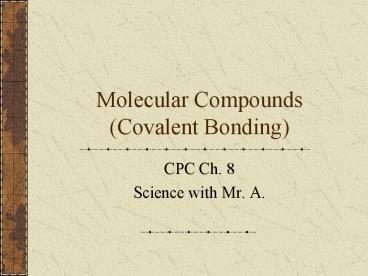Molecular Compounds Covalent Bonding - PowerPoint PPT Presentation
1 / 15
Title:
Molecular Compounds Covalent Bonding
Description:
Any valence electrons that are not paired are called unshared pair'. Such is the case for NH3: ... Valence Shell Electron Pair Repulsion Theory. ... – PowerPoint PPT presentation
Number of Views:69
Avg rating:3.0/5.0
Title: Molecular Compounds Covalent Bonding
1
Molecular Compounds(Covalent Bonding)
- CPC Ch. 8
- Science with Mr. A.
2
Molecules and Molecular Cpds
- The sharing of electrons is covalent bonding.
- When the atoms bond they form a molecule.
- Each molecule is an electrically neutral group of
atoms joined together by covalent bonds. - Combined molecules that form compounds are
molecular compounds. - Usually this is 2 or more non-metals that form a
compound with a low MP/BP. - These molecular compounds are written out by a
molecular formula.
3
Single Covalent Bonds
- SCB have one pair of shared electrons.
- All Halogens form SCBs like H2.
- The electron dot diagram for this is HH.
- The two electrons in the bond can be replaced
with a line (H-H). - The diagram with lines for bonds such as
- H-H is called a structural formula.
4
Single Covalent Bonds
- Any valence electrons that are not paired are
called unshared pair. - Such is the case for NH3
- Atoms will form double and triple covalent bonds
if it allows them to attain the Nobel Gas
configuration. - Ex N2
.
.
N
H
H
_
_
_
N
N
.
.
.
.
.
.
H
.
.
.
.
5
Coordinate Covalent Bonds
.
- Carbon Monoxide bonds differently than water,
ammonia, and carbon dioxide. - Carbon needs four electrons, and Oxygen needs
two. - C 1s2 2s2 2p2
- O 1s2 2s2 2p6
- Here, in the CCB, one atom contribute BOTH the
electrons needed for the bond.
.
O
C
.
.
.
.
.
.
.
.
C
O
.
.
_
_
.
.
_
6
Coordinate Covalent Bonds
- Most polyatomic ions contain both Covalent and
Coordinate Covalent Bonds. - Ex SO32-
.
.
.
.
.
.
.
.
S
O
O
O
2 e-
.
.
.
.
.
.
.
.
.
.
.
.
.
.
.
.
2-
.
.
.
.
.
.
S
O
O
.
.
.
.
.
.
.
.
.
.
.
.
.
.
O
.
.
.
.
.
.
7
Bond Dissociation Energy
- When H2 forms, heat is given off.
- This suggests that the product is more stable.
- Breaking the Cov. Bond of 1 mole of H2 requires
435KJ of energy. - The energy required to break a bond is the Bond
Dissociation Energy.
- The large the energy the stronger the Covalent
Bond. - Ex
- C-C 347 KJ
- CC 657 KJ
- CC 908 KJ
8
Resonance
- When a molecule has two or more possible
structures, it shows resonance. - Here the electrons can move around.
- Ex
- O O O -----gt O O O
9
Bonding Theories
- Molecular Orbitals
- When two atoms combine, their orbitals overlap
forming a Molecular Orbital. - Atomic Orbitals belong to the atom.
- Molecular Orbitals belong to the molecule.
- s s sigma
- Horizontal p Horizontal p sigma
- Vertical p Vertical p pi
10
VSEPR Theory
- Valence Shell Electron Pair Repulsion Theory.
- Remember that a 2-D drawing for CH4 is really a
3-D molecule. - The like charges of Hydrogen atoms on CH4 will
repel each other.
- The angles between the Hydrogen atoms will vary.
- Ex
- CH4 109.5o
- H2O 105o
- NH3 107o
11
Hybrid Orbitals
- VSEPR Theory deals with the shape of the molecule
only. - Hybrid Orbital deals with shape and type of bond.
- Hybrid Single Bond
- CH4 C has an e- config of 1s2 2s2 2p2
- It changes to 1s2 2s 2p3
- Sp3 has an angle of 109.5o
- Sp2 has an angle of 120o
- Sp has an angle of 180o
- Sp bonds always form a tetrahedron.
12
Polar Bonds
- Cov. Bonds share, and by sharing the atoms all
pull on each other. - When they pull evenly it is a Non-Polar Cov.
Bond. - When they pull unevenly it is a Polar Cov. Bond.
- The more electronegative atom attracts electrons
and therefore has a negative charge.
- H Cl-
- H electroneg. 2.1
- Cl electroneg. 3.0
- HCl is polar
- A polar bond makes a polar molecule.
- A molecule with two different charged poles is
called a Dipole.
13
Molecular Attractions
- Intermolecular attractions are weaker than Ionic
or Cov. Bonds. - Van der Waals are the two weakest molecular
attractions - Dipole Interactions polar charge of one
molecule pulls on another molecule. - Dispersions Forces normal movement of the
electron can momentarily polarize a non-polar
molecule.
14
Misc.
- Hydrogen Bonds
- Hydrogen is Cov. Bonded to a very electronegative
atom already bonded to another electronegative
atom.
- Intermolecular Attraction
- Network solids are very stable solids where all
atoms have Cov. Bonds.
15
The End































